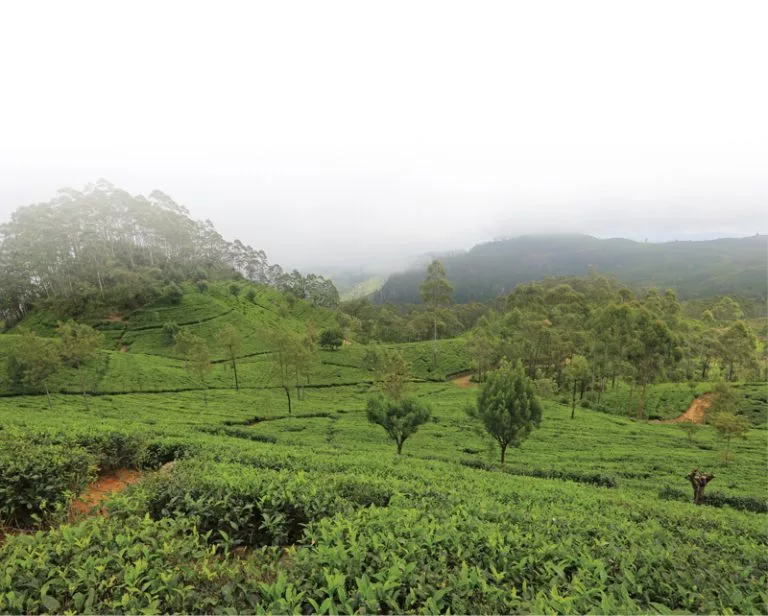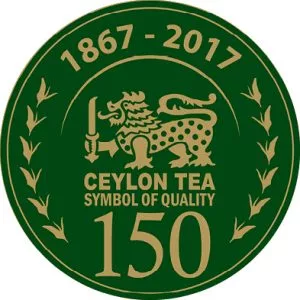
Nourished by the great Cachan winds, Uva tea has an unmistakable aromatic flavour that has made it world renowned. Grown in one of the remotest provinces of Sri Lanka, the harvesting and production of Uva tea is a labour of love that truly defines the nearly 150 years of tea making culture in Sri Lanka.
Words Tharika Fuhrer | Photographs Menaka Aravinda and Anuradha Perera

Uva province is as beautiful as it is vast. Nestled between Kandy and Nuwara Eliya, this lush green wonderland can only be reached through a rigorous drive taking you into the district of Badulla, Uva’s provincial capital. Due to its high elevation, the climate in Uva is cool. It’s terrain mountainous, covered with rolling hills of grassy patanas and blankets of well manicured tea leaves. Trees not seen in other parts of the island like Eucalyptus and Caribbean pine dot the landscape perfectly complimenting the fresh blooms of flowers that bring colour to the otherwise emerald scenery.
With such natural splendour, it is easy to get distracted from Uva’s most prized commodity, it’s tea leaves. Cultivation began in the mid 1800s after rust disease wiped out the coffee crops that the first European planters had tried to cultivate. Tea production thereafter proved to be a success due to Uva’s ideal weather conditions, producing a flavour and bouquet distinctly unique. This exceptional taste has been credited to the Uva season, a period of time that produces the highest quality tea in the province.

This time is characterised by a drought that starts from mid June and goes till September. The lack of rain brings with it the Cachan winds, that travel from the North and North West of the island, moving from Welimada to lower Uda Pussellawa ending at Lunugala where the last estate is. This unpredictable weather phenomenon is what gives Uva tea it’s signature flavour. How this is done is a fascinating process.
The winds have a drying effect on the tea, lowering its fluid levels by interrupting the tea plant’s natural photosynthesis. The process makes the tea leaves dry at a faster rate producing a higher concentration of trace chemicals and aromatic compounds. This physical reaction is what gives Uva tea it’s signature brisk body and fragrant bouquet.
In terms of flavour Uva tea has been described to have a brisk body with a strong taste that is rather ascorbic. Comparable some say, to taking a bite of raw mango. As such Uva tea is often blended, with about one to two kilograms enough to instil flavour into over 50 kilograms of regular tea. For this reason, even though Uva tea can fetch up to four times the price of normal teas, buyers are still able to afford their very competitive prices.
As one might imagine, the coordination of tea manufacture from plucking to tasting is no mean feat. If we try and consider what goes into making a fine cup of Uva tea, then one must start in the field. There was a time that tea was plucked individually by the estate tea plucker whose image has since become an iconic symbol of Sri Lanka. The equipment these tea pluckers use however has changed dramatically in recent years.
Instead of the giant weaving baskets that they used to fashion on their heads, they are now given ergonomically designed holders devised to put less weight on the plucker’s back and shoulders. In addition, they are given selective tea harvesters or plucking shears that have been created to yield the most desired leaf combination, one bud and two leaves (often dubbed mother and sons) at greater frequency than if done by hand.
Harvesting in the Uva province usually happens everyday with about eight to ten plucking rounds. The two most common strains planted are seedlings, which are plants that have grown from seeds and cultivars that grow from the cuttings of seedling plants. Growth during the quality season is very slow. The climate’s inherent dryness makes the tea leaves wither much faster than in any other region. Because of this, manufacturing starts a few hours after the tea is plucked instead of the 15-20 hours as witnessed in other parts of the island.

Once moisture is taken out by allowing the leaves to wilt, the withering process is complete and rolling or disruption begins. This is carried out by machinery that crush and lacerate the leaves ensuring the acids and flavours are ground and concentrated, allowing the process of fermentation to commence. Tea producers can then choose when to arrest the process by putting the tea leaves into dryers thereby manipulating the tea leaves to reach its desired flavour levels.
Once the tea goes through all these stages, it will be graded. This is done by sifting the dhool (processed tea leaves) through a machine fitted with the different sized meshes. The meshes separate the tea into different grades. Although each estate has their own grading preferences most will make; BOP (Broken Orange Pekoe), BOP Fannings, Pekoe and Dust 1. Once the manufacture of the product is completed, the tea is tasted and then shipped to tea brokers. They will sell it at the Colombo tea auction where it can be sold anywhere from 600 rupees to 6,000 rupees a kilogram depending on desirability.
One estate known for its quality yields is Dambatenna tea garden located in Haputale. With a harvest of 1.5 million kilograms of black tea each year, it is the largest tea producer in the province with every single sample of tea manufactured there being personally tasted by Dambatenna estate’s general manager, Hemantha Kahatapitiya. The estate came into being in the late 1800s and was the first property to be acquired by Tea Magnate Sir Thomas J. Lipton, who owned the estate for over forty years. In 1997, Lankem Tea and Rubber Plantations acquired the estate and has managed it since.
Dambatenna estate is a lovely place to visit as it provides visitors with spectacular sights of working in the tea industry. It is also very closely situated to “Lipton’s Seat”, a unique perch offering a 360 degree view of the surrounding area. This is where Sir Lipton would trek up, often entertaining his guests with picnics as he discussed his tea empire and prospects for the future.
Another neighbouring estate located in Bandarawella is Nayabedda. Apart from panoramic views of the whole South East Coast and the North East range, one of the estate’s main attractions is the stunning planter’s bungalow. With beautifully kept gardens, interiors infused with “pastoral prettiness” and furnishing from the early 1900’s, the place is certainly worth a visit. Now home to Ken Murray, a third generation tea planter, the bungalow is the ideal example of how the historical heritage of tea estates can remain perfectly preserved.
As night fell and our trip to Uva came to a close, it may have been my imagination but I could hear the faint call of the Uva birds singing in the distance. I say it’s probably my imagination because the Uva bird is supposed to be a myth, only as real as their representations on the Uva tea logo. The story goes however, that two Uva birds meet once a year. The male flies in from the North. The female from the South. And when they meet they call out to each other in the same one-word song; U-va, U-va, U-va.


